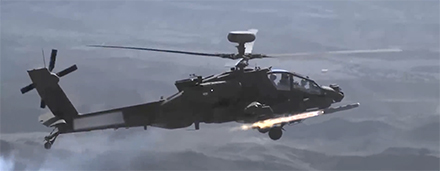FIRE AND BRIMSTONE
The Brimstone missile’s precision-strike capabilities against both moving and stationary targets is said to be the envy of air forces globally. Now MBDA say Brimstone's ‘one missile, multiple platforms’ strategy is a game changer for the industry.
By Anita Hawser
Few missiles have had a Queens Enterprise Award for innovation bestowed upon them. The UK’s Brimstone precision-strike missile was awarded this coveted title in 2014 for its dual-mode semi-active laser/millimetric wave radar seeker, which came out of an Urgent Operational Requirement in Afghanistan for a missile that could be fired in confined or urban areas with
“sub-metric” accuracy.
The Brimstone’s dual-mode seeker has gained an enviable reputation on the global stage for its precision-strike accuracy, making it an effective weapon not only against anti-tank armour, but also against fast-moving targets like vehicles, fast patrol vessels and motorcycles. As the Brimstone missile draws close to a target, the laser hands over to the radar seeker, which is what gives the missile its agility and precision against fast-moving targets, says Andy Allen MBE and head of Land Domain, UK Sales and Business Development at MBDA. “The dual-mode seeker means the Brimstone has come into its own again as a weapon of choice,” he says.
The Brimstone has been in service with the Royal Air Force (RAF) since 2005. The dual-mode seeker was added in 2008. Alongside the Paveway IV dual-mode laser-guided bomb, the Brimstone was the weapon of choice in recent RAF airstrikes against Daesh (ISIS) in Syria and Iraq. On April 2, 2018, according to UK government reports, a Brimstone missile scored a direct hit on a Daesh mortar team operating out of a large building, with minimal damage sustained to the building. Three days later, the Brimstone was used again by the RAF to reportedly destroy a motorcycle carrying three terrorists travelling at speed across the desert.
EXPORT POTENTIAL
The main customer for the Brimstone remains the RAF. Export customers include Saudi Arabia and Qatar. Poland, France, Germany and India have also expressed an interest in the missile. MBDA also put the Brimstone forward for the US’s AGM-179 Joint Air-to-Ground Missile (JAGM) programme to develop an air-to-surface missile to replace the current air-launched BGM-71 TOW, AGM-114 Hellfire and AGM-65 Maverick missiles.
The US wanted to develop a JAGM with improved lethality and targeting against improved tank-armour systems deployed by the Russians and Chinese, which MBDA argues the Brimstone would have been perfect for given its dual-mode seeker. Interestingly, Brimstone started life as a development from the Hellfire programme. However, MBDA ended up fully re-engineering Hellfire. “One of the major requirements of the UK MoD at that time was for the missile to be fired from a fast jet,” explains Kimpton. “It was to rapidly counter the Soviet bloc threat of tanks and armoured personnel carriers advancing en masse and this capability has been retained.”
Kimpton talks about the sheer feat of engineering required to fire a missile from a fast jet. It has to withstand not only the cold and heat, he says, but also vibrations from the aircraft. “You want to avoid the turbulent air throwing the missile against the aircraft,” Kimpton explains. “The Brimstone has a level of integrity that competitor missiles just don’t have. Rocket motors fire for about three seconds to accelerate the missile away from the aircraft. It is deliberately programmed so the aircraft cannot overtake the missile as you don’t want the missile to fly into the aircraft.”
The US ended up awarding a contract to Lockheed Martin, the original developer of the Hellfire missile, to deliver 2,631 JAGMs under an initial low-rate production contract. The JAGM features a “dual-mode” seeker that combines semi-active laser and millimetre wave radar sensors for “fire and forget” precision strike against a variety of stationary and moving targets. A decision regarding full-rate production of the JAGM is scheduled for Q3 next year.
The precursor to JAGM was the AGM-169 Joint Common Missile programme, which was meant to be fired from fast jets, helicopters and UAVs. However, the JCM was cancelled due to budget cuts and replaced by the JAGM, which will be tested and qualified for use on a range of platforms, including helicopters and Remotely Piloted Air Systems (RPAS). But a future upgrade will be needed for it to be fired from a fast-moving fighter jet.
REDUCED LOGISTICS FOOTPRINT
MBDA says the JAGM will not replicate the performance of the Brimstone, which it describes as 'one missile for multiple missions.' “If you’re taking a broader long-term view, the fact that you can use the Brimstone on multiple platforms (fast jets, UAVs, rotary wing, land vehicles and naval vessels) it is the best value for money,” says Kimpton. “It has benefits not only at the sharp end, but also when it comes to training and logistics support.”
On the 30 January this year, the RAF’s Typhoon Force flew its first operational sortie carrying the Brimstone 2 precision-attack missile. In February, the RAF reported that a Brimstone fired from a Typhoon had taken out a boat used by Daesh on the Euphrates river. Brimstone has also been chosen for the RAF’s next-generation Protector (MQ-9B SkyGuardian) RPAS. It has reportedly enjoyed nine successful test firings on the Protector against fast-moving vehicles.
The Brimstone has also been tested on a Boeing AH-64E Apache attack helicopter against main battle tank and pick-up truck targets. Dan Girardin, a Boeing Flight Test Engineer, said for one of the demanding Apache manoeuvring trial shots where the missile hit an MBT turret ring, it was the “most aggressive shot” he had seen in 30 years of the Apache programme.
“One missile, multiple platforms, is a huge game changer,” says Allen. There is still some evaluation work to be done regarding Brimstone on Apache. But once the UK has proven the Brimstone for the rotary-wing platform, Allen anticipates that there will be a ‘domino effect,’ with other countries recognising the financial benefits of having one missile that can operate across multiple-platforms.
The Brimstone is also insensitive munitions compliant, says Allen, which means it can be carried on ships. “In 20 to 30 years time, Brimstone will still be able to meet threats,” he adds. "We’re always looking to develop the system to meet future and current needs.”
Allen says MBDA is currently working with the UK Ministry of Defence to develop a system for using the Brimstone missile to strike fast onshore attack craft, which is an ongoing threat in the Gulf region.
"The Brimstone is low collateral risk in areas where you really need to hit a target. It will hit the middle of a car or a motorbike travelling at high speed."

The RAF's Typhoon Force flew its first operational sortie carrying the Brimstone 2 precision-attack missile on 30 January 2019 (Copyright: MBDA)
Brimstone on Apache: A manoeuvring trial shot where the missile hit an MBT turret ring was described as the “most aggressive shot” in 30 years of the Apache programme.



“A lot of air forces look on with jealousy at the Brimstone,” says Cliff Kimpton, Market Development Executive, Brimstone, UK Sales and Business Development. “It is low collateral risk in areas where you really need to hit a target. It will hit the middle of a car or a motorbike travelling at high speed.”
In 2014, at a US Congress House Armed Services Committee (HASC) hearing, the Brimstone’s ability to defeat a bunch of swarming boats was highlighted by Republican Duncan Hunter, who asked then US Navy Chief of Naval Operations, Admiral Jonathan Greenert, whether he liked the missile and whether it would be used by the US any time soon. “I do like the missile,” Adm. Greenert replied. “But how do I integrate it; how does it perform; how do I get it through the system so it’s not a long programme of record?”




